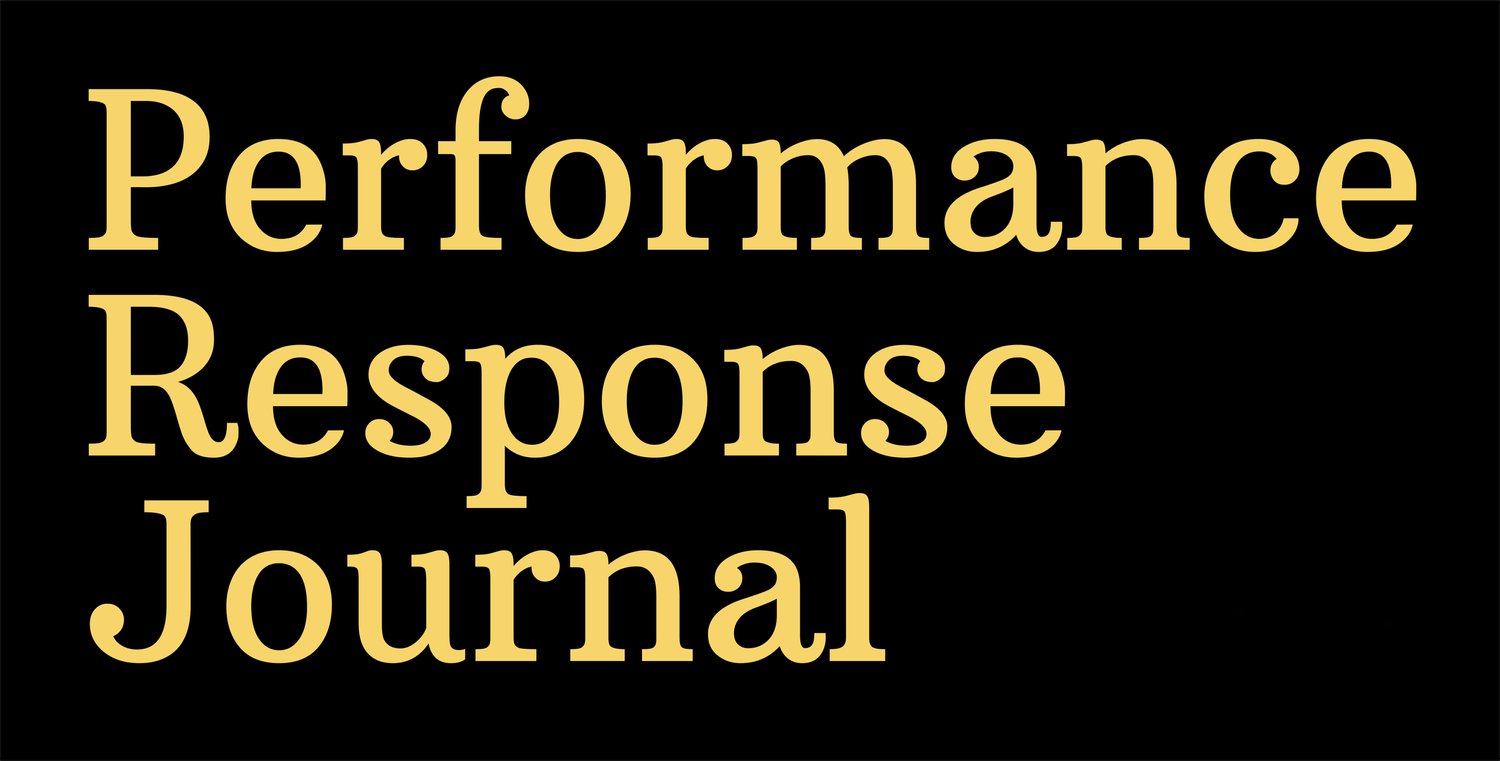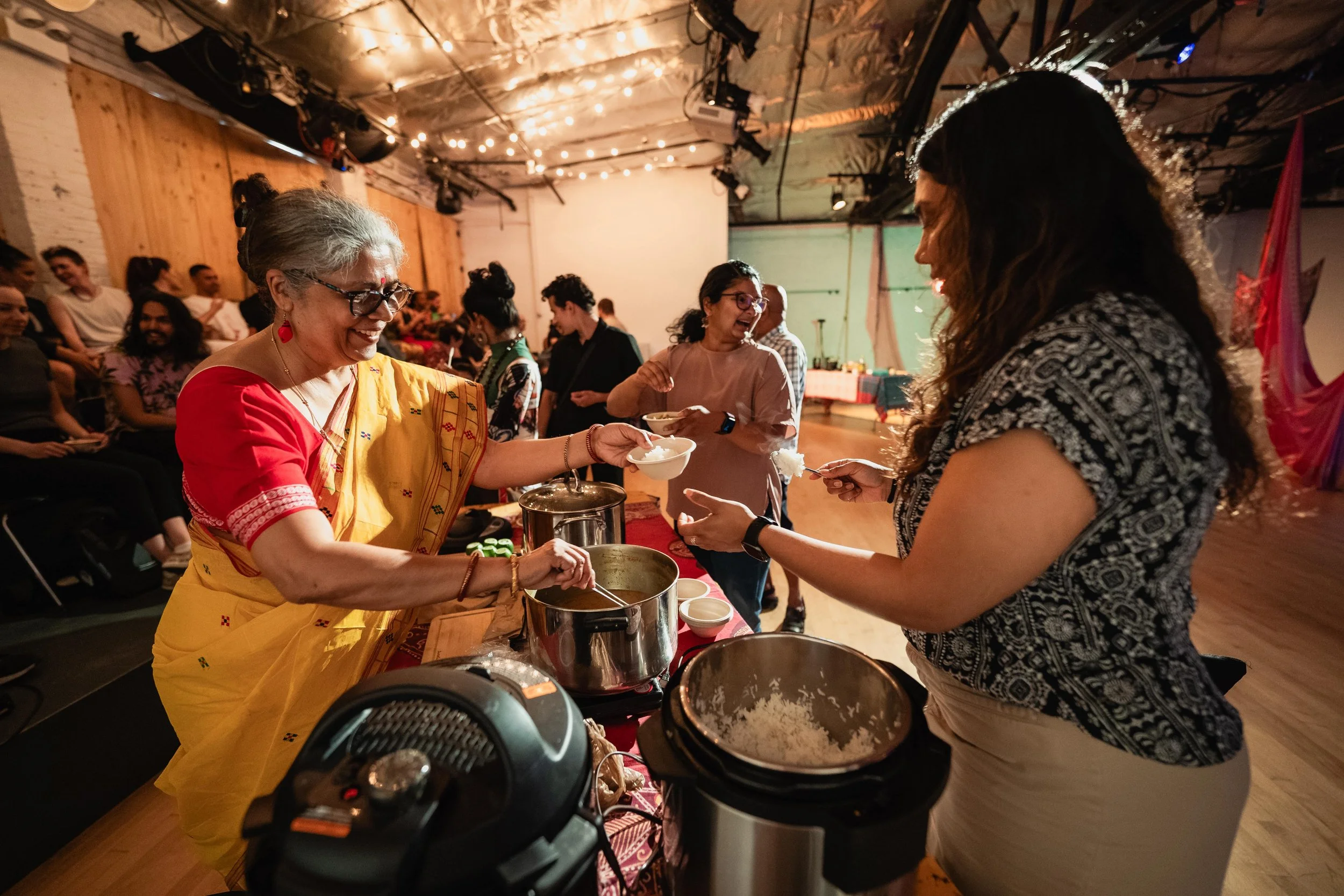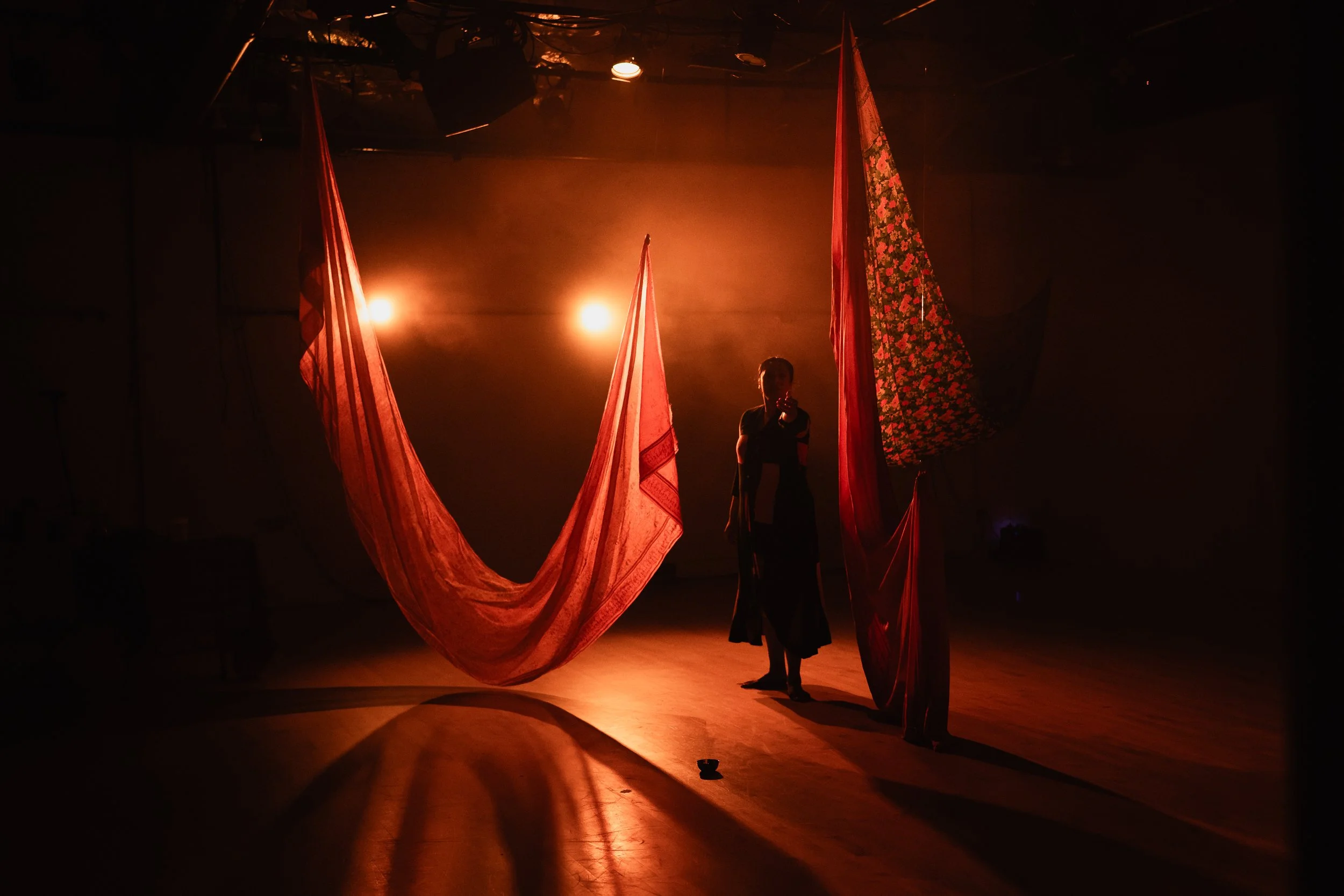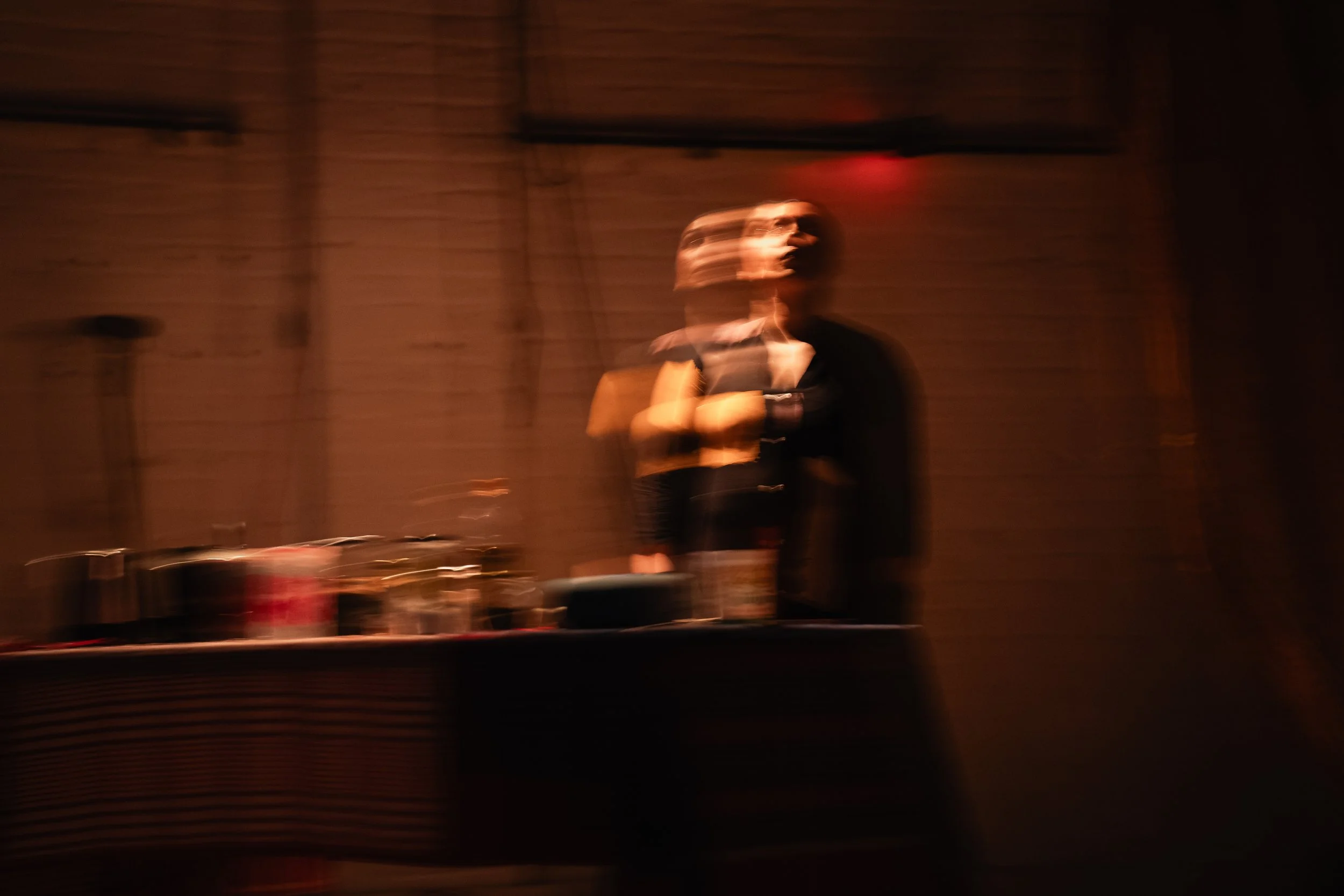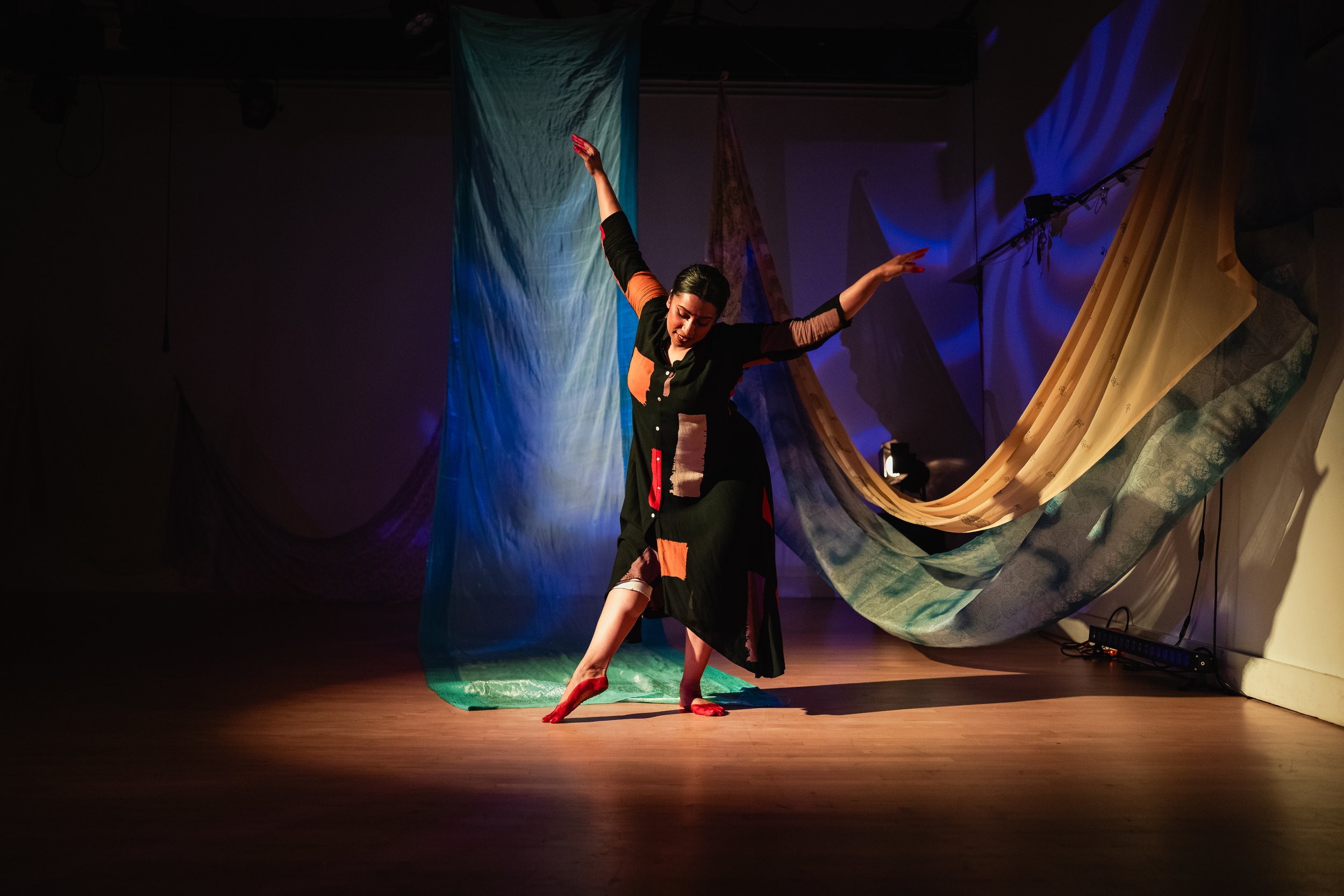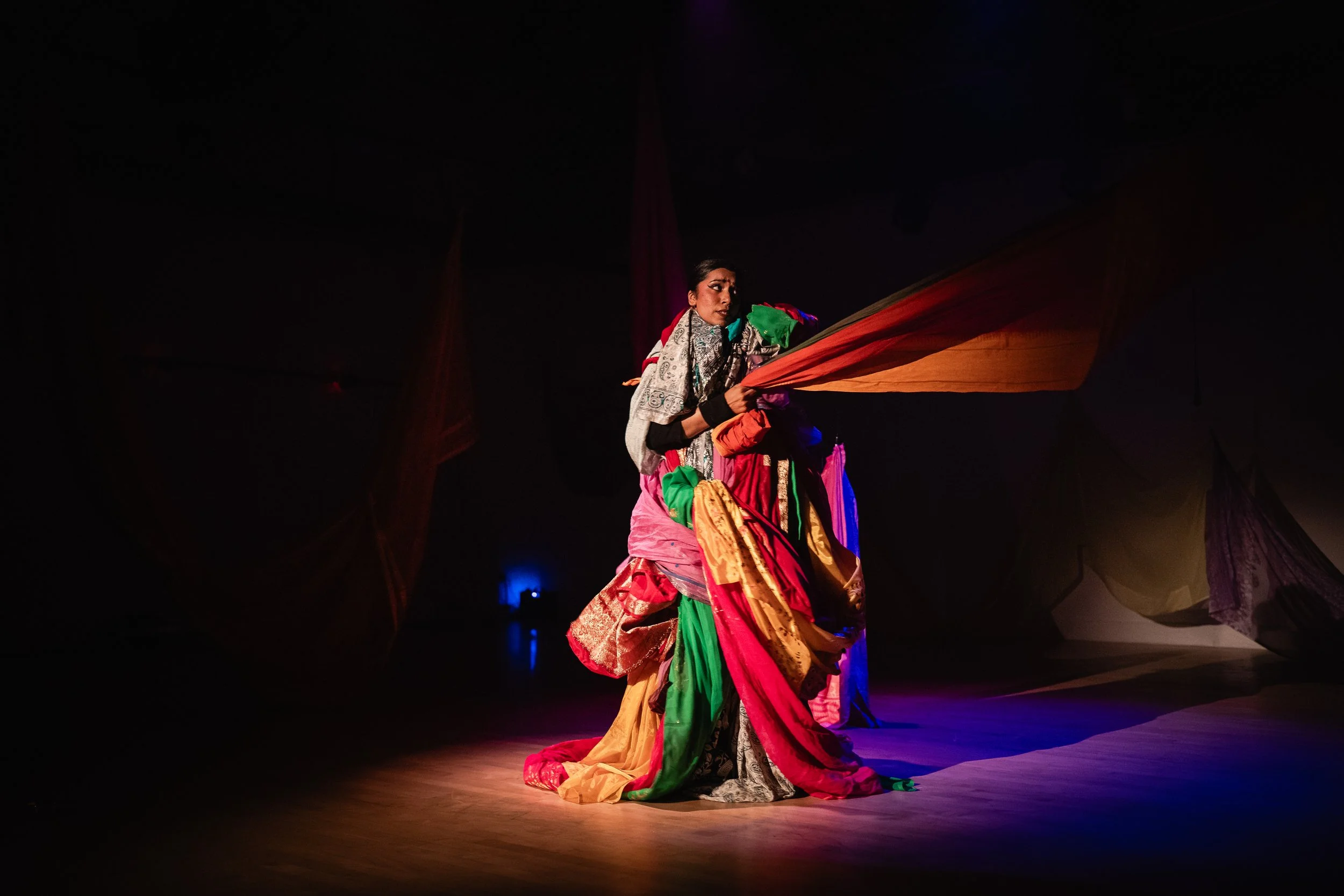Look Both Ways: Reflections on Bangali Meye in its fourth iteration by Maya Odim
Image captured by Ricardo Adame
Bangali Meye
Performed on June 20 & 21, 2025 at Links Hall
THE TEAM:
Tuli Bera: Performer + Director
Brice Hartmann: Project Manager + Emotional Support
Scott Rubin: Viola + Sound Artist
Bob Garrett: Composer
Giau Truong: Lighting + Set
Mira Raven: Vocal Teacher
Maitreyee Bera: Cooking Support
Words from Bera:
During the last 2-3 months of the [Co-MISSION] fellowship, I invited fellow artists/friends to support me during my rehearsal process. These folks have helped shape the work in ways that I could not have done alone. Their witnessing and feedback allowed the solo work to stay alive outside of my [oftentimes] chaotic brain. I am deeply grateful and feel so held: Thank you, Preeti Veerlapati, Ashwaty Chennat, Darling Squire, Tithi Bera, Helen Lee, and Zach Nicol!
*************************
Recipes for eating are passed down in families, recipes for living are passed down in families: a ritual, a practice, an approach. Some of what Tuli Bera has printed on the card I picked up reads: How do we negotiate between what is inherited and self-defined? What rituals will it create and carry forward? What rituals has it forgotten? What rituals does it know?
Thoughts of family recipes passed down like family rituals, and family rituals passed down like answers, and answers passed down like memories, and memories passed down like invitations to open and decide how to use engulfed me that night, and continues to sit with me. Inheritance is not something done to us, it is something done with us; when we trace the influences in our lives/when we ask and answer questions about ourselves, what we decide.
At Links Hall on June 21, 2025 I witnessed the fourth iteration of Bangali Meye. At the door, there was a card, double sided: a recipe on one side and thoughts printed on the other.
Earlier this year I heard poet Diego Báez —who is living and working in Chicago— talk about inheritance as bidirectional. It awakened an understanding within me: inheritance does not just fall and land, it is caught and guided. The inheritance/s I understood Báez was talking about were ritual, behavior, and practice. In both Báez’s talk and Bera’s performance inheritance transcends the physical, bridging spiritual, emotional, and cultural places converting at the point where one meets themselves.
Image captured by Ricardo Adame
Bangali Meye emboldened within me the awareness that inheritance is not passive, it is not something you just take with you, or the act of being hooked to something; inheritance involves you, it invites you to —in the words of Bera— trace, it tells you something has come before you and calls you to figure out where it has come from, and what it will be now that it has met you: looking back and looking forward. In the past I have carried fear about how well I was carrying on what I identify I’ve inherited from my ancestors: my great grandmother’s Sofrito recipe, my aunty’s Moi Moi recipe; my grandmother’s pickling practice and my grandfather’s fluency in Igbo. And in witnessing Bangali Meye I came to an understanding that inheritance is not mimicry, nor is it replication, it is making a place for regeneration.
What has this meant and what does it mean to me? Nothing is lost in the re-arranging or rendering of a ritual passed down; tracing requires decision-making.
The evening of the show, the first to greet me at the door was a warm smell of food. Shortly after finding a seat I was handed —though I feel too like I was gifted— a bowl of masoor dal with rice. With a full bowl of food and in a room filled with music and conversation, food and ingredients, cloth and lights, I filled up.
The staged area was set up in front of where the audience was sitting. When entering the room there was a table immediately welcoming me in, from which Bera’s mom was serving food, and across from this table was another filled with ingredients for cooking. Filling the space between the two tables were many different pieces of cloth, of different patterns and colors, hanging in different ways from the ceiling above.
At some point I realized I hadn’t noticed when music started, or if it had been playing before I entered the room, but there was a moment when I started to notice a voice, more distant than those in the room, and I started to hear cracklings and vibrations from the speakers. Throughout the show voices, instruments, and field recordings of cooking were layered by Scott Rubin to make up the live soundscape, along with which Rubin also played viola that evening. Rubin also drew from a sample bank they’d created with a comrade musician.
Some would say this was the room before the show started, but I’d encourage everyone to think of this as the start of the show. Bera then comes on stage, behind the table full of ingredients for cooking, the lighting changes and a spotlight falls on this table. An onion is peeled.
peeling an onion
reaching to see the temperature of the pan
hovering their hand over its surface
a measured tap, a measuring tap
of the fingers
to test the heat.
As Bera continued cooking they read words that called in the ancestors of the land we were on/that Links Hall is on, calling in the spirit and memory of the First Nations Indigenous people of that land. Acknowledgements.
Testing the heat, pouring oil and acknowledging land.
Testing the heat.
A jar of spices opened to the air
a sprinkle of spice
leads the laying of the onion in the pan.
It sizzles
my family chosen and blood, alive and dead.
Image captured by Ricardo Adame
Bera speaks to us (alive and dead) in that room while cooking.
Smoke rises
...you are now part of this container…I invite you…
The spoon goes into the pan.
The sounds of this forming and transforming and becoming
masoor dal.
Spices guide a dish the way I understand what I inherit guides me (towards and away from): the making of a recipe will I follow/the following of a recipe I will make.
Tap, screw, swipe.
Spoon.
Push, shift/in the pan.
a teacher an anchor
tasting and thinking, ancestry, recipe, and languages.
As the food was set to cook, Bera started to move from behind “the cooking table”, dancing between spotlights on the floor, reminding me of worlds one exists between, reflecting languages and rituals Bera exists between/mother tongues, mother practices, and mother lands. Part of my family's immigration story meets me as a second generation Igbo American with Afro-Cuban bisabuelos (great grandparents). I’ve grown up around family who is constantly moving between worlds, I learned at a young age that I was from more than one place, and I continue to arrange these places within myself.
My choices of food, adornment and communication have always been a part of this: the ways I decorate my body with tattoos are manifestations of my duality, the images in them both anchor and position me within cultural lineages; I have never been able to shop at only one grocery store because of the different kinds of ingredients I’m eating and with which I’m cooking; the different cloth I use to wrap my hair and the wrappers I use for my body are living and changing with me as I grow into understanding where I’m from in relation to where I’ve grown up (I think this is why I find more of what suits me in thrift stores when I’m in the states). Among many different experiences, witnessing Bangali Meye made me experience fearlessness about practicing rituals in the ways that are meaningful for me and not only in the ways I’ve been taught them to mean.
One of the first places Bera lands after moving from behind the ‘cooking table’ is to a place behind one of the sheerer clothes suspended from above. The contrasting blurred but visible image of Bera behind the curtain, with the crisp outline of their shadow made by the positioning of the lighting above, was an inviting interplay of elements echoing of duality. Bera behind the cloth and Bera’s shadow represented for me an example of —like theorized by W. E. B. Du Bois and Franzt Fanon— a double-consciousness: seeing oneself through our own eyes and seeing oneself through the perception of someone else.
Life is behind our eyes and spirit is behind our practices.
Image captured by Ricardo Adame
I remember Bera talking about loss and longing. Moving from behind the cloth, Bera notices us again. Decidedly talking to us. With words yes, but with body vocabulary: with gaze, with finger tips, with head direction, all reaching us in deliberate ways.
Plucking of the air, the strings
of sound and thought, pluck me
hovering, knowing how to
land, and landing
and taking off, and landing.
Bera moving behind, in between, and with the cloth draped around the stage reminded me of the elements one moves through, hangs on to/from, ducks under or approaches. Bera’s body was pulled around the space by stories of ritual, of tongues, of healing, of death. Bera lit spiritual lights (candles/conduits), and danced with the lights in the room. The colors of the lights changed as the focus of the words changed. I remember greens, reds and blues, warm yellows, oranges and yellow-white and grounding shadows on the floor and walls that created black and grey tones too.
We can’t avoid our shadow.
I remember lightning landing on Bera, in a circle, and as the light continued to cast I noticed another spotlight light behind them, and then one shadow in the spotlight behind them and a second shadow behind the first, landing outside of both spotlights. Does lineage not look like this? Doesn’t lineage look like this: a shadow casting shadow, casting shadows…
As the temperature rises
the smell is stronger.
A light fell on a bowl of mustard seed oil, and then another light fell next to this which Bera moved inside of. Bera talks about food rituals, and food as medicine. Food is for the body and for the spirit. Bera says: Cured by her touch. I think her is mother and that mother is many: is language, is ritual, is caregiver; is more.
From the ground.
Healing, reaching, balancing.
Bera talks about Bangali Meye, about awareness, about respect and about honoring through memory. The lights change.
Green, blue, red, faaaaaaaade
Reaching, greeting, pushing
holding, rising, grabbing a hold of
a holy ghost moment.
Memory in practice
memory is a ritual.
We inherit past lives.
What we inherit is not a mandatory directive, rather an example, a guide, part of a line we trace as part of the shape of ourselves we are drawing. Bera reminds us to be bold in this tracing. Redirecting not rejection.
Image captured by Ricardo Adame
Bera's movement, the soundscape, and lightning were ingredients in a recipe/they made a story, reflecting what I understood as the experience of growing up between places, between spaces and in between expectations, illuminating and offering the need to set direction for oneself/to discover one self/to decide for oneself what shadows we will cast, what spaces we will exist between and what will drape around us.
We can’t avoid our shadow.
Does lineage not find us like this?
The motions wish the body.
This is the tightrope, you constantly move back and forth/bidirectionally.We have to both learn from our ancestors and make our own rituals by being where we are and learning from where we’ve come.
Rituals, beliefs and practices.
Seek out people from whom to learn.
We, ourselves, find people from whom to learn.
Some of the final movements of the show reminded me of what Bera had been talking about, in practice. What appears to be a single cloth starts to descend from the ceiling, which we then see is tied to another cloth, that is tied to another cloth, and another . . . an almost never-ending ribbon of cloth. Bera catches each piece and drapes them on their body, some wrapped, some hung, all piling up. Like the different cloth hanging around the staged area, I imagine the different colors and patterns of the cloth Bera is catching to represent receiving different kinds of inheritances.
This fourth iteration of Bangali Meye reminded me of how inheritance accumulates in us, we receive and re-direct it, and there is not loss in re-direction. We carry within us all of the tools and the maps we need to be and find who we are. Bera reminds that the body is a container — and all her ritualistic tools fit inside of it. Traveling with us wherever we go, accessible whenever we need — as Bera negotiates moving throughout the room/with cloth/with sound/with memory/with story.
honor, and honoring memory finds space inside of me
not in a building or in my walk
it's in the mind. So it can happen whenever, wherever.
How we live is made up of rituals, and
so too is memory, a ritual.
honor through memory
Place to place, encounters
in space: hands reaching, greeting, pushing
holding, rising, grabbing
a hold of.
There were moments of calm approach, furious play, meditative force, energetic patterns, playful directions, balanced speed, holy ghost movement, loving confidence.
Jump/twirl/spin
shaking, back and forth, and/back and forth and
grabbing an anchor held in the body.
Kick like a moon cycle: waxing and weaning
from there to there/point to point
from here to here within.
Lean on lineage. Let it to us.
Bera encourages tracing what runs through us/trace what we’ve come from, who and where; trace what’s in our lives to understand its form(s) to understand ourselves. We have to leave what doesn’t serve us and hold on to what does. This is one way to negotiate space.
inheritances accumulate
on us
how will they lay.
Image captured by Ricardo Adame
*************************
Maya Odim has an interdisciplinary practice rooted between poetry and movement, anchoring an artistic approach to dealing with communication. Maya overlaps symbolisms of language with vocabularies of gesture. Working collaboratively and independently, Maya has received honorable mention in the 2024 Ruth Weiss Foundation Poetry Competition, was an interdisciplinary artist in residence at Ragdale (2023) and The Poor Farm, WI (2024). Maya has self published poetry and been published in places including F News Magazine, Performance Response Journal, and Chicago DanceMakers Forum Blog. Maya is a Poet in Residence with the Chicago Poetry Center and lecturers in the English department at Roosevelt University and in Theater and Performance Studies at the University of Chicago. Some of Maya's work can be found online here: www.mayaodim.com and here: @maya.odim

